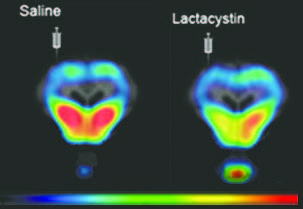New publication from the Department of Nuclear Medicine and PET Center
Extending the ubiquitin-proteasome system (UPS) inhibition rodent model of Parkinson’s disease to the larger Göttingen minipig by injecting the UPS inhibitor, lactacystin, directly to the nigrostriatal pathway.

Parkinson's disease (PD) is characterized by degeneration of dopaminergic neurons in the substantia nigra leading to slowness and stiffness of limb movement with rest tremor. Using ubiquitin proteasome system inhibitors, rodent models have shown nigrostriatal degeneration and motor impairment. We translated this model to the Göttingen minipig by administering lactacystin into the medial forebrain bundle (MFB). Minipigs underwent positron emission tomography (PET) imaging with (+)-?-[11C]dihydrotetrabenazine ([11C]DTBZ), a marker of vesicular monoamine transporter 2 availability, at baseline and three weeks after the unilateral administration of 100??g lactacystin into the MFB. Compared to their baseline values, minipigs injected with lactacystin showed on average a 36% decrease in ipsilateral striatal binding potential corresponding to impaired presynaptic dopamine terminals. Behaviourally, minipigs displayed asymmetrical motor disability with spontaneous rotations in one of the animals. Immunoreactivity for tyrosine hydroxylase (TH) and HLA-DR-positive microglia confirmed asymmetrical reduction in nigral TH-positive neurons with an inflammatory response in the lactacystin-injected minipigs. In conclusion, direct injection of lactacystin into the MFB of minipigs provides a model of PD with reduced dopamine neurotransmission, TH-positive neuron reduction, microglial activation and behavioural deficits. This large animal model could be useful in studies of symptomatic and neuroprotective therapies with translatability to human PD.
Full text link: https://www.ncbi.nlm.nih.gov/pubmed/29428213
